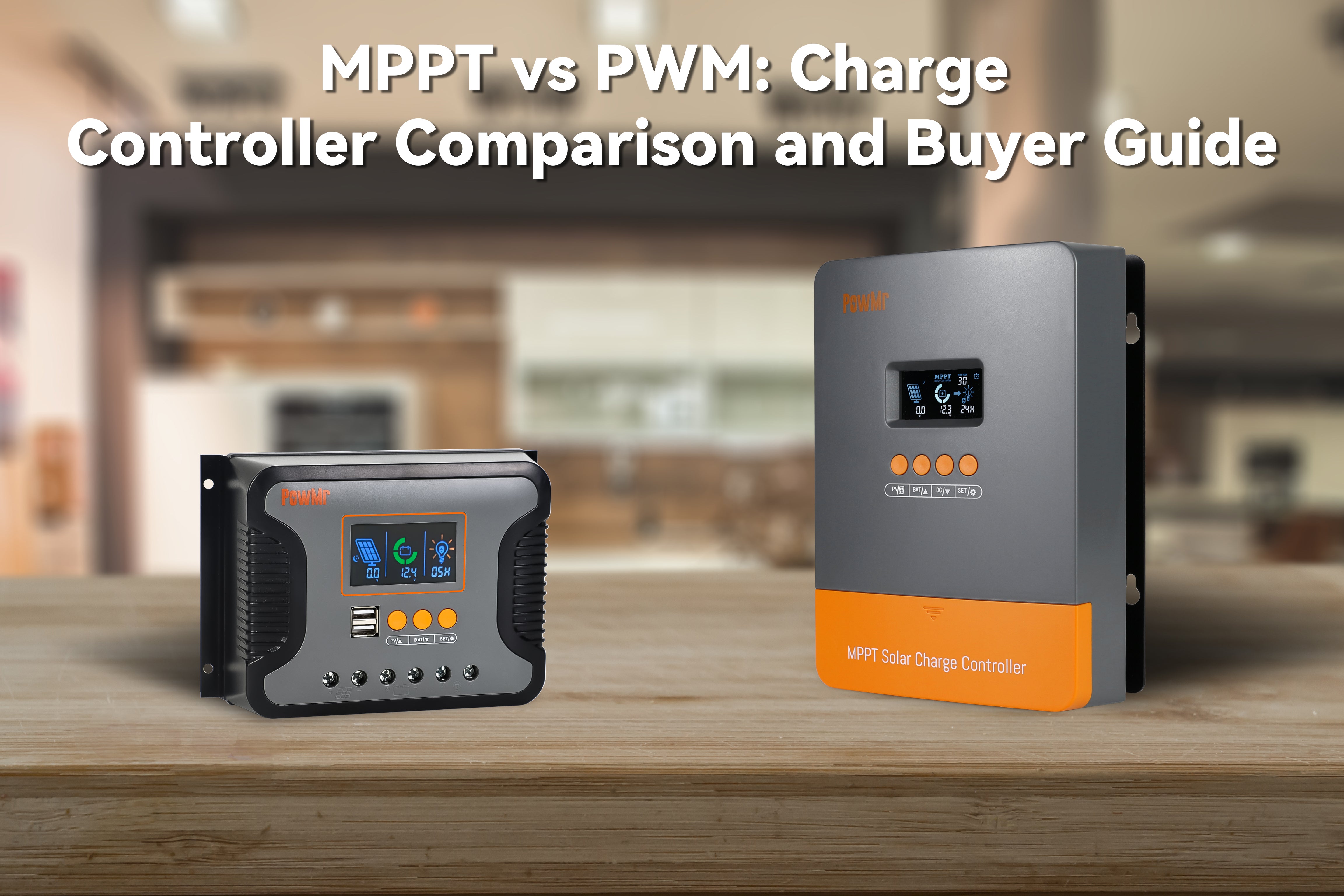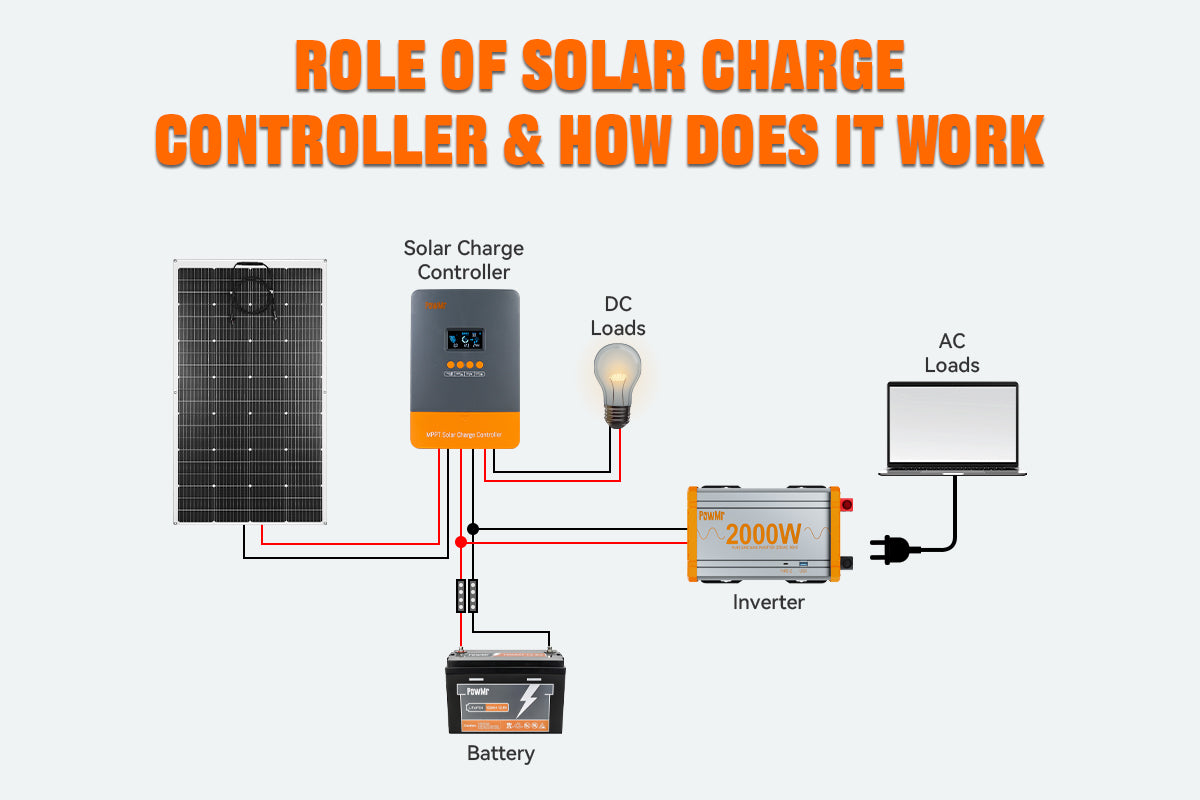อินเวอร์เตอร์ในระบบพลังงานแสงอาทิตย์ สามารถใช้งานอุปกรณ์หลายเครื่องพร้อมกันได้ เมื่อการติดตั้งระบบพลังงานแสงอาทิตย์ที่มีอินเวอร์เตอร์ขนาด 3000W หนึ่งในปัจจัยสำคัญคือการเลือกขนาดแบตเตอรี่ที่เหมาะสมเพื่อให้มั่นใจได้ว่ามีพลังงานที่เชื่อถือได้และสม่ำเสมอ ไม่ว่าคุณจะใช้พลังงานสำหรับบ้าน รถ RV หรือกระท่อมที่อยู่นอกระบบ ความจุของแบตเตอรี่จะส่งผลโดยตรงต่อระยะเวลาที่อินเวอร์เตอร์ของคุณสามารถจ่ายพลังงานได้
ในการประเมินจำนวนแบตเตอรี่ที่คุณต้องการสำหรับอินเวอร์เตอร์ 3000W คุณต้องพิจารณา การใช้พลังงานระยะเวลาการใช้งาน และ ขนาดแบตเตอรี่
ในบล็อกนี้ เราจะอธิบายความเข้ากันได้ของอินเวอร์เตอร์โซลาร์เซลล์ 3000W ภายในระบบพลังงานแสงอาทิตย์ที่กว้างขึ้น และให้การคำนวณทีละขั้นตอนของจำนวนแบตเตอรี่ที่จำเป็นตามการใช้พลังงานของคุณ
รายการเนื้อหา
การอ้างอิงการกำหนดค่าของแบตเตอรี่
(อิงจากอินเวอร์เตอร์ 3000W ที่โหลดเต็ม 4 ชั่วโมง/วัน ประสิทธิภาพ 95% และความลึกของการคายประจุ 80%):
| ความจุของแบตเตอรี่ | ระบบ 12V | ระบบ 24V | ระบบ 48V |
|---|---|---|---|
| 100อา. | แบตเตอรี่ 16 ก้อน | แบตเตอรี่ 8 ก้อน | แบตเตอรี่ 4 ก้อน |
| 200อา.ม. | แบตเตอรี่ 8 ก้อน | แบตเตอรี่ 4 ก้อน | แบตเตอรี่ 4 ก้อน |
| 150อา.ม. | แบตเตอรี่ 12 ก้อน | แบตเตอรี่ 8 ก้อน | แบตเตอรี่ 4 ก้อน |
💡หมายเหตุ: ความต้องการที่แท้จริงอาจแตกต่างกันไปขึ้นอยู่กับสภาพแวดล้อมการใช้งาน ประเภทของแบตเตอรี่ ฯลฯ สำหรับการคำนวณที่แม่นยำ โปรดดูคำแนะนำโดยละเอียดด้านล่าง
ขั้นตอนที่ 1 - กำหนดว่าอินเวอร์เตอร์ 3000W จะใช้งานอะไรและใช้พลังงานเท่าไหร่
โปรดทราบว่ากำลังไฟฟ้าที่ระบุของอินเวอร์เตอร์แสดงถึงความจุสูงสุดของมัน แต่การใช้พลังงานจริงจะขึ้นอยู่กับอุปกรณ์เฉพาะที่เชื่อมต่อกับมันและระยะเวลาที่ใช้งาน
กล่าวอีกนัยหนึ่ง การใช้พลังงานไม่ได้ขึ้นอยู่กับกำลังไฟฟ้าชื่อกำกับของอินเวอร์เตอร์ 3000W แต่ขึ้นอยู่กับ กำลังไฟฟ้าของอุปกรณ์ ที่คุณพยายามจะใช้งานและ ระยะเวลา ที่คุณต้องการให้มันทำงาน
อินเวอร์เตอร์ 3000w จะใช้งานอะไรได้บ้าง?
ด้านล่างนี้ เราได้สรุปสถานการณ์การใช้พลังงานสองแบบที่จำนวนแบตเตอรี่ที่ต้องการอาจแตกต่างกัน เพื่อให้ได้การประเมินที่แม่นยำ โปรดระบุโหลดเฉพาะ ที่จะใช้งานกับอินเวอร์เตอร์ 3000W ตามสถานการณ์จริงของคุณ
เครื่องใช้ในครัวเรือน
อินเวอร์เตอร์ 3000W สามารถใช้งานร่วมกับเครื่องใช้ไฟฟ้าภายในบ้านได้หลากหลาย อย่างไรก็ตาม สิ่งที่สำคัญแต่มักถูกมองข้ามคือการเข้าใจ ความต้องการแรงดันไฟฟ้าของโหลดของคุณ—ไม่ว่าจะเป็น อินเวอร์เตอร์ 3000W ที่มีเอาต์พุต 220V AC หรือ อินเวอร์เตอร์ 3000W ที่มีเอาต์พุต 110V AC ที่จำเป็น
นอกจากนี้ สิ่งสำคัญคือต้องตรวจสอบให้แน่ใจว่า โหลดเหนี่ยวนำ ที่เชื่อมต่อ ไม่เกินความจุไฟกระชาก/กำลังไฟสูงสุด ของอินเวอร์เตอร์เพื่อป้องกันความเสียหายต่ออินเวอร์เตอร์
อินเวอร์เตอร์ 3000 วัตต์เพียงพอสำหรับการจ่ายพลังงานให้กับตู้เย็น โคมไฟหลายดวง เครื่องชงกาแฟ คอมพิวเตอร์ และการชาร์จสมาร์ทโฟนในระบบ RV ทั่วไปที่มีการใช้พลังงานต่ำ
หากภาระงานสูง จำเป็นต้องประเมินการใช้พลังงานของอุปกรณ์ไฟฟ้าอย่างรอบคอบและพิจารณาอัปเกรดเป็นอินเวอร์เตอร์ที่มีกำลังสูงขึ้นเพื่อให้ระบบทำงานได้อย่างถูกต้อง
นี่คือภาพรวมสั้น ๆ ของการใช้พลังงานของเครื่องใช้ไฟฟ้าทั่วไปต่าง ๆ
- ตู้เย็น: 350- 800 วัตต์
- เครื่องซักผ้า: 500-1000 วัตต์
- ไมโครเวฟ: 600-1200 วัตต์
- เครื่องปิ้งขนมปัง: 800-1500 วัตต์
- เครื่องชงกาแฟ: 600-1200 วัตต์
- Blender: 300-1000 วัตต์
- แล็ปท็อป: 25 -150 วัตต์
- ไดร์เป่าผม: 900 - 1600 วัตต์
สำหรับระบบพลังงานแสงอาทิตย์ในบ้าน คนส่วนใหญ่จะเก็บพลังงานในช่วงกลางวันและใช้ในช่วงเย็นเพื่อ ประหยัดค่าใช้จ่ายตามอัตรา Time-of-Use (TOU) ในกรณีนี้ คุณเพียงแค่ต้องคำนวณการใช้พลังงานของครัวเรือน ในช่วงเวลาที่มีความต้องการสูงสุด เท่านั้น
อย่างไรก็ตาม หากคุณต้องการใช้ แบตเตอรี่เป็นแบ็คอัพ ในช่วงไฟฟ้าดับ ให้ทำรายการรายละเอียดของอุปกรณ์ในบ้านทั้งหมดที่จะใช้พลังงานจากแบตเตอรี่ รวมการใช้พลังงานของแต่ละอุปกรณ์และคำนึงถึงระยะเวลาที่คาดว่าจะเกิดไฟฟ้าดับ
อุปกรณ์ทางการแพทย์
เมื่อใช้เครื่องแปลงไฟฟ้า (inverter) เพื่อจ่ายพลังงานให้กับอุปกรณ์เช่นเครื่อง CPAP ให้ให้ความสำคัญกับความปลอดภัย ความน่าเชื่อถือ และความเข้ากันได้กับอุปกรณ์ทางการแพทย์ที่ตั้งใจใช้ นอกเหนือจากความเข้ากันได้ของแรงดันไฟฟ้าและความถี่ อุปกรณ์ทางการแพทย์ต้องการแหล่งจ่ายไฟที่เสถียร เลือกใช้ เครื่องแปลงไฟฟ้าความถี่ต่ำ ที่มีเอาต์พุต คลื่นไซน์บริสุทธิ์ ซึ่งคล้ายกับไฟฟ้าจากกริดอย่างใกล้ชิด เพื่อลดความเสี่ยงในการทำให้อุปกรณ์ทางการแพทย์ที่บอบบางเสียหาย ตรวจสอบให้แน่ใจว่าสามารถจ่ายไฟได้อย่างรวดเร็วในช่วงไฟดับหรืออุบัติเหตุ ทำหน้าที่เป็น UPS เพื่อรับประกันการสนับสนุนที่ไม่ขาดตอนสำหรับผู้ป่วย
นอกจากนี้ อุปกรณ์ทางการแพทย์มักต้องทำงานเป็นเวลานาน ดังนั้นระยะเวลาสำรองที่ยาวนานขึ้นจึงมีความสำคัญสำหรับการทำงานที่ไม่ขาดตอน
นอกจากกำลังไฟฟ้าของอุปกรณ์ไฟฟ้าแล้ว ยังเป็นสิ่งสำคัญที่จะต้องพิจารณา ประสิทธิภาพของอินเวอร์เตอร์ เพื่อชดเชยการสูญเสียพลังงานในระหว่างกระบวนการแปลงพลังงาน
บันทึก:
โดยทั่วไป อินเวอร์เตอร์ยังใช้พลังงานสำหรับการทำงานของตัวเอง แม้ว่าการใช้พลังงานนี้จะค่อนข้างต่ำ โดยปกติจะ น้อยกว่า 2% ของพลังงานรวมทั้งหมด สำหรับการประมาณที่แม่นยำมากขึ้น คุณสามารถเพิ่มการใช้พลังงานนี้เข้าไปในพลังงานรวมได้
ดังนั้น ความต้องการพลังงานที่แท้จริงจะถูกคำนวณตามสูตรด้านล่างนี้:
- ความต้องการพลังงาน(วัตต์) = กำลังไฟฟ้ารวม(วัตต์) / ประสิทธิภาพอินเวอร์เตอร์
ในคำนวณต่อไปนี้ เราสมมติว่าอินเวอร์เตอร์ 3000W ทำงานที่กำลังไฟเต็มที่โดยมี ประสิทธิภาพ 95%
ตอนนี้ มาแทนค่ากันเถอะ:
ความต้องการพลังงาน = 3000W / 0.95 3158 𝑊
ดังนั้น ความต้องการพลังงานที่แท้จริงจะอยู่ที่ประมาณ 3158W เพื่อชดเชยการสูญเสียพลังงานเนื่องจากประสิทธิภาพของอินเวอร์เตอร์
ขั้นตอนที่ 2 - แปลงวัตต์เป็นแอมป์
จำนวนแบตเตอรี่ที่ต้องใช้สำหรับอินเวอร์เตอร์ 3000W ยังขึ้นอยู่กับ แอมแปร์ต่อชั่วโมง (AH) และ แรงดันไฟฟ้าที่กำหนด (V) ของแบตเตอรี่ด้วย ไม่ว่าคุณจะมีอยู่แล้วหรือวางแผนที่จะซื้อใหม่
สมมติว่าอินเวอร์เตอร์ของคุณทำงานกับระบบแบตเตอรี่ 24V และคุณต้องการทราบว่าคุณจะต้องใช้แบตเตอรี่กี่ก้อนเพื่อจ่ายพลังงานให้กับอุปกรณ์ของคุณ ซึ่งมีกำลังรวม 3000 วัตต์
ในการคำนวณนี้ ก่อนอื่นคุณต้องแปลง 3000 วัตต์เป็นแอมป์โดยใช้สูตร P/V=I (ความต้องการพลังงาน/แรงดันแบตเตอรี่ = กระแสไฟฟ้า) ในกรณีนี้ 3000 วัตต์ หารด้วย 24 โวลต์ เท่ากับ 125 แอมป์
เพื่อชดเชยการสูญเสียพลังงาน คุณอาจต้องการประมาณ 3158W ซึ่งแปลงเป็นประมาณ 132 แอมป์
ขั้นตอนที่ 3 - คำนวณจำนวนแบตเตอรี่สำหรับอินเวอร์เตอร์ 3000 วัตต์
อินเวอร์เตอร์ 3000W จะทำงานได้นานแค่ไหน?
เนื่องจากความจุของแบตเตอรี่ถูกวัดเป็นแอมป์-ชั่วโมง (Ah) จึงเป็นสิ่งสำคัญที่จะต้องแปลงแอมป์เป็น Ah เมื่อคำนวณโดยการคูณแอมป์ด้วยชั่วโมง โปรดพิจารณา เวลาการทำงานของอินเวอร์เตอร์ ที่ต้องการอย่างรอบคอบเพื่อให้แน่ใจว่ามีการจ่ายไฟอย่างต่อเนื่อง
ตัวอย่างเช่น หากอินเวอร์เตอร์ของคุณทำงานเป็นเวลา 6 ชั่วโมงและต้องการกระแสไฟฟ้า 132 แอมป์ คุณจะต้องใช้พลังงาน 792 แอมป์-ชั่วโมง (132 แอมป์ × 6 ชั่วโมง)
เพื่อยืดอายุการใช้งานของแบตเตอรี่ ควรรักษา ระดับการปล่อยประจุของแบตเตอรี่ (DoD) ให้อยู่ในระดับที่ปลอดภัย
สุดท้าย คุณสามารถกำหนดจำนวนแบตเตอรี่ได้โดยการ หาร แอมป์-ชั่วโมงด้วยความจุแบตเตอรี่ที่คุณเลือก พร้อมทั้งคำนึงถึงความลึกของการปล่อยประจุของแบตเตอรี่ในการคำนวณด้วย
จำนวนแบตเตอรี่ = กระแสไฟฟ้าที่ต้องการ / ความจุแบตเตอรี่ * DoD
ดังนั้น เพื่อให้ตรงกับความต้องการพลังงานนี้ คุณจะต้องใช้ 8แบตเตอรี่ 24 โวลต์ แต่ละก้อนมีความจุ 100 แอมป์-ชั่วโมง โดยรักษาความจุแบตเตอรี่ให้อยู่เหนือ 20% ทั้งหมดเชื่อมต่อแบบขนานกัน
โพสต์ที่เกี่ยวข้อง:
บทสรุป
โดยสรุป การกำหนดจำนวนแบตเตอรี่ที่ต้องใช้สำหรับอินเวอร์เตอร์ 3000W ขึ้นอยู่กับการใช้พลังงานของคุณ ประสิทธิภาพของอินเวอร์เตอร์ แรงดันแบตเตอรี่ และความจุ ปัจจัยสำคัญได้แก่ ระยะเวลาการใช้งานอินเวอร์เตอร์และกำลังโหลดรวม การคำนวณที่ถูกต้องช่วยให้มั่นใจได้ถึงการจ่ายพลังงานที่เชื่อถือได้และอายุการใช้งานแบตเตอรี่ที่ยาวนานขึ้น
ขั้นตอนการคำนวณที่ระบุไว้ข้างต้นสามารถรวบรวมเป็นสูตรดังต่อไปนี้:
- จำนวนแบตเตอรี่ = กำลังไฟฟ้ารวมของโหลด (วัตต์) / (แรงดันแบตเตอรี่ (โวลต์) × ความจุแบตเตอรี่ (แอมป์-ชั่วโมง) × ความลึกของการคายประจุ (DoD) × ประสิทธิภาพของอินเวอร์เตอร์)
คำถามที่พบบ่อยเกี่ยวกับอินเวอร์เตอร์ 3000W
อินเวอร์เตอร์ 3000 วัตต์ต้องการกี่แอมแปร์-ชั่วโมง?
มันขึ้นอยู่กับแบตเตอรี่และภาระของคุณ ยิ่งแบตเตอรี่ใหญ่ อินเวอร์เตอร์ 3000W จะใช้งานได้นานขึ้น หากภาระของคุณทำงานเต็มกำลังและอุปกรณ์ของคุณมีพลังงาน 2000W และแรงดันแบตเตอรี่ของคุณคือ 50V กระแสที่ต้องการคือ 40A หากคุณเปลี่ยนแบตเตอรี่ 4000Ah เป็น 8000Ah เวลาทำงานจะเพิ่มเป็นสองเท่า
ฉันสามารถเปิดเครื่องปรับอากาศด้วยอินเวอร์เตอร์ 3000 วัตต์ได้ไหม?
ใช่ อินเวอร์เตอร์ 3000 วัตต์สามารถใช้งานเครื่องปรับอากาศส่วนใหญ่ได้ หากคุณไม่แน่ใจหรือต้องการสอบถามเพิ่มเติม คุณสามารถติดต่อฝ่ายบริการลูกค้าของ PowMr Store และเราจะอธิบายให้คุณอย่างใจเย็น
อินเวอร์เตอร์ 3000 วัตต์จะสามารถใช้งานเตาไมโครเวฟได้หรือไม่?
แน่นอนว่าอินเวอร์เตอร์ 3000W สามารถใช้งานเตาไมโครเวฟ 900W และความต้องการกระแสไฟกระชาก (การใช้พลังงานตอนเริ่มต้น) 2,700W ได้อย่างง่ายดาย คุณไม่ต้องกังวลว่าอินเวอร์เตอร์ที่คุณซื้อจะไม่สามารถรองรับโหลดได้ บริการลูกค้าของเราจะให้คำตอบแบบมืออาชีพแบบตัวต่อตัว



